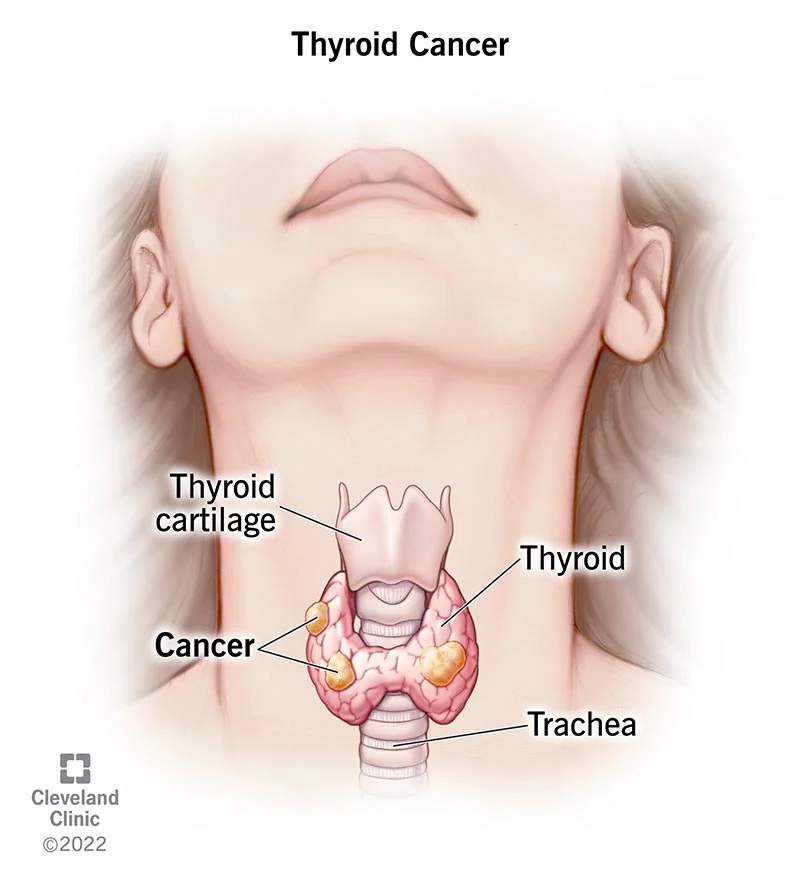Introduction
What is Thyroid Cancer?
Thyroid cancer is a type of malignant tumor that arises from the gland, a small, butterfly-shaped endocrine gland located at the base of the neck, just below the Adam’s apple.
This crucial gland plays a pivotal role in regulating metabolism, heart rate, and body temperature by producing essential hormones.

Anatomy of the Thyroid Gland
The thyroid gland is composed of two lobes connected by a narrow strip of tissue called the isthmus. The lobes are lined with follicular cells, which are responsible for producing thyroid hormones, primarily triiodothyronine (T3) and thyroxine (T4).
These hormones are transported throughout the bloodstream to exert their effects on various tissues and organs.
Types of thyroid cancer
There are four main types :
Papillary Thyroid Cancer:
This is the most common type , accounting for about 80% of all cases. It is usually slow-growing and highly treatable.
Follicular Thyroid Cancer:
This is the second-most common type, accounting for about 10% of all cases. It is also usually slow-growing and highly treatable.
Medullary Thyroid Cancer:
This is a less common type, accounting for about 3% of all cases. It is more likely to spread to other parts of the body than papillary or follicular thyroid cancer.
Anaplastic thyroid cancer: This is the most rare and aggressive type of thyroid cancer, accounting for less than 1% of all cases. It is fast-growing and can be difficult to treat.
Symptoms of Thyroid Cancer: Recognizing the Signs of This Endocrine Disorder
While many individuals with thyroid cancer may not exhibit any noticeable symptoms, several telltale signs can emerge as the tumor grows and disrupts the delicate balance of hormones produced by this crucial gland.
These symptoms serve as important cues to seek medical attention and prompt a thorough evaluation for thyroid cancer.
1. Neck Lump or Bulge:
The presence of a palpable lump or swelling in the neck, typically just below the Adam’s apple, is a common early indicator of disease
This lump, often painless and firm to the touch, represents an enlargement of the thyroid gland, a hallmark of the disease.
2. Voice Changes:
As the thyroid gland enlarges or the tumor invades surrounding structures, it can affect the delicate laryngeal nerves responsible for voice production.
This can manifest as a range of voice changes, including hoarseness, difficulty speaking, or a noticeable change in voice pitch.
3. Swallowing Difficulties:
Dysphagia, or difficulty swallowing, is another potential symptom of thyroid disease. The enlarged gland or tumor can compress the esophagus, the tube that carries food from the mouth to the stomach, making swallowing a challenging and uncomfortable task.
4. Neck Pain:
While neck pain can arise from various causes, it can also be a symptom of thyroid cancer. This pain, often localized to the area of the enlarged gland, may be constant or intermittent and can intensify with swallowing or neck movement.
5. Enlarged Lymph Nodes:
Lymph nodes, small bean-shaped structures that play a vital role in the immune system, are often found in the neck region. When thyroid cancer spreads, it can involve these lymph nodes, causing them to swell and become palpable.
6. Weight Loss or Gain:
Thyroid hormones regulate metabolism, the body’s process of converting food into energy. Disruptions in thyroid hormone production can lead to unexpected weight fluctuations, including unexplained weight loss or gain.
Unraveling the Causes of Thyroid Cancer: A Multifactorial Puzzle
While the precise etiology of thyroid disease remains elusive, advancements in medical research have shed light on several factors that can heighten an individual’s risk of developing this endocrine malignancy.
Understanding these risk factors empowers individuals to make informed choices and healthcare providers to tailor preventive strategies.
1. Age: A Threshold for Risk
The incidence of thyroid cancer exhibits a marked age-related pattern, with a significant increase in risk observed beyond the age of 40.
This age-dependent susceptibility is attributed to a combination of factors, including age-related changes in cellular processes, environmental exposures, and genetic predisposition.
2. Gender: Female Predominance
Women are disproportionately affected by this type of cancer, accounting for approximately 60% of all cases.
This gender disparity is partly attributed to hormonal fluctuations, particularly during pregnancy and menopause, which can influence thyroid function and cell growth.
3. Familial Legacy: A Genetic Connection
A family history of thyroid cancer is a significant risk factor, indicating a genetic predisposition to the disease.
Certain inherited genetic mutations, such as those in the RET gene, can disrupt cell signaling pathways and increase the likelihood of this disease development.
4. Iodine Deficiency: A Nutritional Imbalance
Iodine, an essential mineral for thyroid hormone production, plays a crucial role in maintaining thyroid gland health.
A deficiency in iodine can lead to goiter, an enlarged gland, and an increased risk of thyroid cancer. Also, this deficiency is particularly prevalent in regions with iodine-deficient soils and water sources.
5. Radiation Exposure: An Unseen Threat
Exposure to ionizing radiation, such as from X-rays, nuclear fallout, or radiation therapy for other cancers, can damage the gland cells and increase the risk of thyroid cancer development.
This risk is particularly elevated with childhood exposure, as the thyroid gland is more susceptible to radiation damage during this developmental stage.
6. Other Potential Risk Factors
While the aforementioned factors are well-established risk contributors, research continues to explore additional potential risk factors, including certain dietary habits, lifestyle choices, and exposure to environmental toxins.
Preventive Measures: Taking Charge of Thyroid Health
So, while there is no definitive way to prevent thyroid cancer, adopting preventive measures can help mitigate the risk and promote overall this gland health. These measures include:
*Ensuring adequate iodine intake through a balanced diet or iodine supplements
*Maintaining a healthy weight and engaging in regular physical activity
*Limiting exposure to unnecessary radiation from X-rays or other medical procedures
*Avoiding smoking and excessive alcohol consumption
*Promptly addressing any thyroid-related concerns with a healthcare provider
By understanding the causes and adopting preventive measures, individuals can empower themselves to reduce their risk of thyroid cancer and maintain optimal gland health.
Treatment for Thyroid Cancer: A Tailored Approach to Combatting Endocrine Malignancy
As directed, the treatment strategy for thyroid cancer is carefully tailored to the specific characteristics of the disease, including its type, stage, and the patient’s overall health.
This individualized approach ensures optimal outcomes while minimizing potential side effects and complications.
1. Surgery: The Cornerstone of Treatment
Surgery remains the cornerstone of treatment for the majority of thyroid cancers, particularly papillary and follicular thyroid cancers.
The extent of surgery depends on the stage of thediseaser, ranging from partial thyroidectomy (removal of part of the thyroid gland) to total thyroidectomy (removal of the entire gland).
2. Radioactive Iodine Therapy: Ablating Remnant Cancer Cells
Radioactive iodine therapy (RAI) is a highly effective treatment option for patients with this ilness who have undergone surgery, may have residual cancer cells or are at high risk of recurrence.
RAI utilizes radioactive iodine, a substance taken orally, to selectively target and destroy thyroid tissue.
3. Hormone Therapy: Replenishing Essential Hormones
Following a thyroidectomy, patients require hormone therapy to replace the hormones that the thyroid gland no longer produces.
In addition, levothyroxine, a synthetic thyroid hormone, is the mainstay of hormone therapy, ensuring the maintenance of normal thyroid function and overall health.
4. Chemotherapy: Targeting Aggressive Cancers
The use of drugs to kill cancer cells is primarily reserved for advanced or aggressive types of thyroid cancer, such as anaplastic disease.
This chemotherapy can be administered alone or in combination with other treatment modalities.
5. Prognosis for Thyroid Cancer: A Beacon of Hope
The prognosis for thyroid cancer is generally very favorable, with excellent survival rates. For papillary and follicular thyroid cancers, the five-year survival rate exceeds 90%, and the ten-year survival rate surpasses 98%.
Early detection, prompt treatment, and regular follow-up care are crucial for achieving optimal outcomes.
Thyroid cancer: Early Detection and Prompt Action,The Key to Successful Treatment
The presence of any of these symptoms, particularly in combination, warrants a prompt consultation with a healthcare provider. Early detection and timely intervention are crucial for achieving optimal outcomes in thyroid cancer treatment.
Through a combination of physical examination, diagnostic tests, and appropriate treatment modalities, individuals with this anomaly can enjoy a high quality of life and a positive long-term prognosis.
Factors Influencing Prognosis
Several factors influence the prognosis for thyroid cancer, including:
Type and stage of disease: Early-stage papillary and follicular thyroid cancers have an excellent prognosis.
Age: Younger patients generally have a better prognosis than older patients.
Overall health: Patients with good overall health tend to have a more favorable prognosis.
Conclusion:
Thyroid cancer, while a serious condition, is highly treatable with a remarkably positive prognosis. With advances in diagnostic and therapeutic approaches, individuals with thyroid cancer can expect a high quality of life and long-term survival.
The prognosis for thyroid cancer is generally very good. The five-year survival rate for people with this cancer is over 98%. However, the prognosis depends on the type and stage of cancer, as well as your overall health.
If you are concerned about your risk of thyroid cancer, talk to your doctor. They can help you determine your risk factors and recommend appropriate screening tests.




